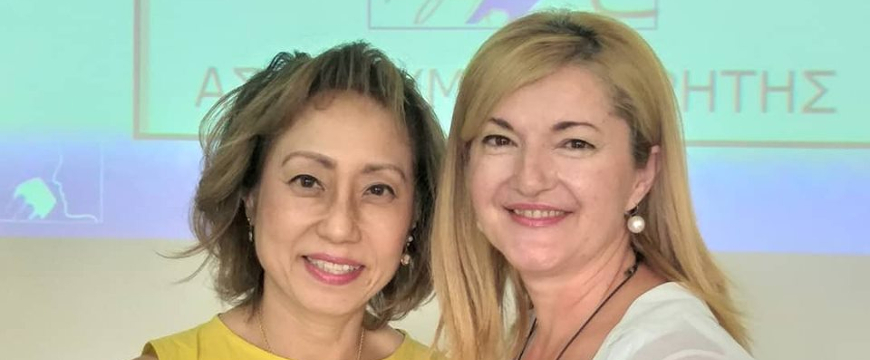Visiting Crete, a Japanese olive oil taster, international competition judge, and journalist shared her inside knowledge of the Japanese olive oil market with Cretan dignitaries and award winning olive oil producers. Miciyo Yamada helped celebrate the Cretans’ achievements as they emphasized quality and considered their position in the international market.
Now living in Milan, Italy, Yamada was a guest at a September gathering at the Organoleptic Laboratory of the Agricultural Cooperative of Rethymno--an evening to celebrate excellence by recognizing Cretan olive oil companies that won international awards. With Exporters’ Association of Crete vice president Emmanouil Karpadakis translating from Italian to Greek, Yamada presented information about the olive oil market in Japan that may be useful to companies interested in exporting there.
Mentioning that Japan has a population of 127 million, Yamada explained that “eating habits in Japan have been changing rapidly.” More Japanese people eat at restaurants now than in the past, with Italian food their second favorite cuisine when eating out, after Japanese (followed by French and Chinese cuisine). In Japanese homes, Italian dishes such as spaghetti and risotto are among the most popular foods, second only to Japanese dishes.
According to Yamada, one recent survey showed that a majority of interviewees considered food quality fairly important, with 14.2% “extremely interested” in it. Perhaps the “15% increase in olive oil imports to Japan” in the past six years is related to that interest, as Yamada reported that the highest quality olive oil, extra virgin olive oil (EVOO), is the type preferred for import.
However, only 2.3% of this olive oil was imported from Greece, while 50.7% came from Spain, 44.5% from Italy, and 2.5% from other countries. The Acci Gusto exposition in Japan each October which is open only to Italian professionals helps explain that striking Italian presence. (Since Spain is the world’s largest olive oil producer, its contribution is unsurprising.)
Professionals from various countries are welcome at Foodex Japan, with the next edition coming up March 10-13, 2020. There are also two olive oil competitions in Japan, JOOP and Olive Japan, and they sponsor various promotional events.
Yamada mentioned that the Japanese are interested in learning about the quality, history, and culture behind products. EVOO is a symbol of health for them. So it would be useful to emphasize these topics when reaching out to Japanese buyers and consumers.
The Japanese market has particular requirements that potential exporters should consider. For example, olive oil must have a shelf life of at least six months. Japanese shops are very small, with limited space, so they order only one or two bottles at a time. (Supermarkets may order more.) These bottles must be square-bottomed to optimize limited shelf space at home and in stores. Their labels must look perfect (not crooked or dirty), or the bottles will be taken off the shelf.
However, it is important to understand that Italian and other Mediterranean restaurants buy the largest amount of olive oil in Japan overall, covering more than 40% of the total olive oil market there.
Yamada suggested that many Japanese consumers prefer spicier EVOOs, but she also reported that most of them are just beginning to learn about different types of olive oil and to understand the meaning of “extra virgin.” They are not yet aware of the details. For example, they know little about the significance of organic certification, so organic olive oils comprise just 10 to 12% of sales.
Her Cretan audience followed Yamada’s presentation with interest. The event’s organizer, international olive oil judge and director of the tasting lab Eleftheria Germanaki, pointed out that this was only one of many informative seminars for olive oil producers, millers, and other professionals at her lab.
The Rethymno lab’s influence also reaches much farther, since Germanaki’s work on the Cretan Olive Oil Competition and her participation in several other major national and international competitions, as well as her presentations in China, enable her to familiarize consumers, buyers, and judges of many nationalities with Cretan extra virgin olive oil.
Representatives from several awarded Cretan companies were honored at this evening event at the lab, with many crediting Germanaki for showing them the way to improve their olive oil and enter the international market. “It’s not an easy road,” said George Tzianoudakis of Cretanthos, winner of the Best of Crete award at the TerraOlivo Mediterranean International Olive Oil Competition in Israel this year.
Emphasizing the importance of cooperating to work toward a culture of olive oil quality in order to earn the higher price required by Crete’s more expensive traditional cultivation practices, George Andreadakis, president of the Association of Olive Oil Labeling Producers of Crete (SYTEK), added, “it is a difficult road, but a one-way road.”
A number of other Cretan dignitaries agreed. For example, Manolis Chnaris, Vice Governor for the Primary Sector in Crete, was one of several to emphasize the importance of focusing on “quality and only quality” for Cretan olive oil.
This event was organized by the Organoleptic Laboratory of the Agricultural Cooperative of Rethymno in collaboration with the Prefecture of Crete and the Associations of Cretan Exporters and Cretan Bottlers.
All businesses, organizations, and competitions involved with Greek olive oil or agrotourism or food tourism in Greece, as well as others interested in supporting Greeks working in these sectors, are invited to consider the advertising and sponsorship opportunities on the Greek Liquid Gold: Authentic Extra Virgin Olive Oil website. With more than 200 original articles and recipes, the only wide-ranging English-language site focused on news and information from the Greek olive oil world has reached readers in 195 countries around the globe.



